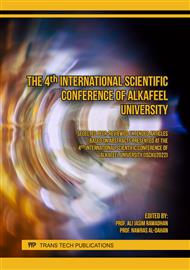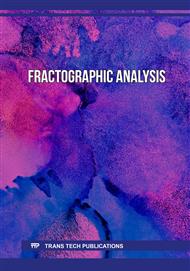[1]
Sheeba, M., and Devadasan, J.J. (2015). Modeling of high-performance Narrowband Antireflection Coating for Visible spectrum. International Journal of Material science Innovations 3: 16-23.
Google Scholar
[2]
Macleod, H.A. (2010).Thin Films Optical Filter, fourth ed, NewYork, USA, Taylor &Francis Group.
Google Scholar
[3]
Lesnic, D. Wakefield, G. Sleeman B.D., and Ockendon, J.R.( 2010). Determination of the index of refraction of anti-reflection coating. Mathematics-in-Industry. Case Studies Journal 2: 155-173.
Google Scholar
[4]
Hedayati, M.K., and Elbahri, M. (2016). Antireflection Coatings: Conventional Stacking Layers and Ultrathin Plasmonic Metasurfaces. Materials 9: 497, https://doi.org/10.3390/ ma9060497.
DOI: 10.3390/ma9060497
Google Scholar
[5]
Khan, I. and Rahman, M.M. (2013). Polarization analysis of antireflection coating for SOS material system. Optics 2: 42-46.
DOI: 10.11648/j.optics.20130203.11
Google Scholar
[6]
Chen, H.T. Zhou, J.J. Ohara, F., and Taylor, A.J. (2010). A Numerical Investigation of Metamaterial Antireflection Coatings. Terahertz Science and Technology 3: 66-73.
Google Scholar
[7]
Dobrowolski, J. A., (1995). Optical Properties of Films and Coatings, Handbook of Optics, Ch42, New York, USA: McGraw-Hill.
Google Scholar
[8]
Bahrami, A., Mohammadnejad, S. Abkenar, N.J. and Soleimaninezad, S. (2013). Optimized Single and Double Layer Antireflection Coating for GaAs Solar Cells. International Journal of Renewable Energy Research 3: 80-83.
Google Scholar
[9]
Ali, K., Khan, S.A., and Matjafri, M.Z. (2014). Effect of a double layer (SiO2/TiO2) Anti-reflective Coating on Silicon Cells. International Journal of Electrochemical Sciences 9: 7865-7874.
Google Scholar
[10]
Oraizi, H., and Abdolali, A. (2008). Design and Optimization of Planar Multilayer Antireflection Metamaterial Coatings at KU band under Circularly Polarized Oblique Planar Wave Incidence. Progress In Electromagnetic Research 3: 1-18.
DOI: 10.2528/pierc08021906
Google Scholar
[11]
Kats, M.A. Bymes, S.J. Blanchard, R. B. Kolle, M. Genevet, P.Aizenberg, J., and Capasso, F. (2013). Enhancement of absorption in ultra-thin highly absorbing optical coatings. Applied Physics Letters 103:101-104.
DOI: 10.1063/1.4820147
Google Scholar
[12]
Medhat, M. Elzaiat E.S. Farag S.G. Youssef, G. and Alkhadry, R. (2016). Enhancing silicon solar cell efficiency with double layer antireflection coating. Turk Journal of Physics 40: 30-39.
DOI: 10.3906/fiz-1508-14
Google Scholar
[13]
Duyar, O., and Durusoy, H.Z. (2004). Design and Preparation of Antireflection and Reflection Optical Coatings. Turk Jornal Physics 28: 139-144.
Google Scholar
[14]
Pedrotti, F.L., and Pedrotti, L.S. (1987). Introduction to Optics, New Jersey, USA: Prentice- Hall International; inc.
Google Scholar
[15]
Abd Algafgffar, A. N. Rashid, H. G. Salman, S. A, and Ali, A. H.(2016). Design of non –Polarizing Antireflection Coatings in visible range 300-800 nm. International Journal of Scientific & Engineering Reseach. Vol.7. Issue 3. Pp. 277-280.
Google Scholar
[16]
Abbas, S. I., S. R. Salman and Hashim, S.S. (2017). Modeling of high-performance reflection coatings for visible region. Australian Journal of Basic and Applied Science 11: 186-193.
Google Scholar
[17]
Qiang. Li.et all (2019). Tunable Perfect Narrow-Band Absorber Based on a Metal-Dielectric-Metal Structure, 9(6), 393;
DOI: 10.3390/coatings9060393
Google Scholar
[18]
Zhang, B. Hendrickson, J. Nadar, N. Chen, H.T., and Guo, J.(2014). Metasurface optical antireflection coating. Applied Physics Letters Vol. 105 Issue.24. Doi.org/
DOI: 10.1063/1.4904827
Google Scholar
[19]
Ovcharenko, A.P. Bilozertsevs, V.I., and Gaman, D.A. (2013). The specificity of Antireflective Coatings at Oblique Incidence of Light. Proceedings of the International Conference on Nanomaterials: Applications and Properties Vol. 2 No 2, 02FNC23(4pp) (2013) http://essuir.sumdu.edu.ua/handle/123456789/35369.
Google Scholar
[20]
Tikhonravov, A.V. Zhupanov, V.G. Fedoseev, V.N, and Trubetskov, M.K.(2014). Design and production of antireflection coating for the 8-10 μm spectral region.Vol. 22 No.26
DOI: 10.1364/OE.22.032174
Google Scholar



